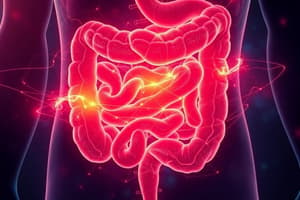Podcast
Questions and Answers
What is the primary basis for the evidence supporting current therapies for Irritable Bowel Syndrome (IBS)?
What is the primary basis for the evidence supporting current therapies for Irritable Bowel Syndrome (IBS)?
- Meta-analyses of older therapies and large randomized controlled trials (RCTs) of novel agents. (correct)
- Retrospective analyses of patient charts without control groups.
- Small-scale pilot studies conducted in single centers.
- Expert opinions and anecdotal case studies.
Why is it important to review the epidemiology and pathophysiology of IBS when discussing its diagnosis and therapy?
Why is it important to review the epidemiology and pathophysiology of IBS when discussing its diagnosis and therapy?
- To highlight the limitations of current diagnostic criteria and treatment options.
- To establish a rational basis for its diagnosis and therapy. (correct)
- To offer a theoretical understanding of IBS without practical implications.
- To provide historical context on how IBS treatments have evolved over time.
In the context of Irritable Bowel Syndrome (IBS) management, what is the significance of disease-modifying treatments?
In the context of Irritable Bowel Syndrome (IBS) management, what is the significance of disease-modifying treatments?
- They are unavailable for IBS, limiting the scope of therapeutic interventions.
- They aim to alter the course of the disease, offering potential long-term benefits beyond symptomatic relief. (correct)
- They are exclusively used in combination with palliative care to improve quality of life.
- They primarily focus on alleviating acute symptoms without addressing the underlying causes.
What role do meta-analyses play in shaping our understanding and treatment of Irritable Bowel Syndrome (IBS)?
What role do meta-analyses play in shaping our understanding and treatment of Irritable Bowel Syndrome (IBS)?
How do clinical features, such as patient history, contribute to the diagnosis of Irritable Bowel Syndrome (IBS)?
How do clinical features, such as patient history, contribute to the diagnosis of Irritable Bowel Syndrome (IBS)?
Which of the following best explains the role of bloating in the diagnosis of Irritable Bowel Syndrome (IBS)?
Which of the following best explains the role of bloating in the diagnosis of Irritable Bowel Syndrome (IBS)?
How do the Manning criteria contribute to the diagnosis of IBS, and what is a key limitation of these criteria?
How do the Manning criteria contribute to the diagnosis of IBS, and what is a key limitation of these criteria?
In the context of diagnosing IBS, what is the primary purpose of establishing the Rome criteria, and how do they improve upon previous diagnostic tools?
In the context of diagnosing IBS, what is the primary purpose of establishing the Rome criteria, and how do they improve upon previous diagnostic tools?
What is a significant consideration when using symptom-based criteria like the Manning or Rome criteria for diagnosing IBS?
What is a significant consideration when using symptom-based criteria like the Manning or Rome criteria for diagnosing IBS?
How does the Kruis scoring system assess the likelihood of IBS, and what role do physical examination findings play in this assessment?
How does the Kruis scoring system assess the likelihood of IBS, and what role do physical examination findings play in this assessment?
Flashcards
Irritable Bowel Syndrome (IBS)
Irritable Bowel Syndrome (IBS)
A common gastrointestinal disorder characterized by abdominal pain and altered bowel habits.
Meta-Analyses
Meta-Analyses
Summaries of multiple studies to determine the overall effectiveness of a treatment.
Randomized Controlled Trials (RCTs)
Randomized Controlled Trials (RCTs)
Studies where participants are assigned randomly to different treatment groups.
Pathophysiology
Pathophysiology
Signup and view all the flashcards
Disease-Modifying Treatments
Disease-Modifying Treatments
Signup and view all the flashcards
IBS Definition
IBS Definition
Signup and view all the flashcards
Manning Criteria
Manning Criteria
Signup and view all the flashcards
Kruis Scoring System
Kruis Scoring System
Signup and view all the flashcards
Rome Criteria
Rome Criteria
Signup and view all the flashcards
Physical Exam Findings in IBS
Physical Exam Findings in IBS
Signup and view all the flashcards
Study Notes
- Irritable Bowel Syndrome (IBS) is a significant health concern due to its high prevalence, substantial impact on individuals, and considerable economic costs.
- IBS is characterized by abdominal pain linked to changes in bowel habits.
- A common symptom of IBS is bloating, but is not essential for diagnosis.
- Individual symptoms alone aren't reliable for diagnosing IBS.
Clinical Features
- Abdominal pain must be present to diagnose IBS.
- IBS pain can either worsen or improve with bowel movements and is linked to changes in stool frequency and consistency
- Pain location is unpredictable, tends to wax and wane, and may be worsened by eating.
- Pain is most commonly felt in the lower abdomen
- Life events or difficult situations commonly exacerbate IBS pain.
- Continuous pain unrelated to bowel movements or triggered by menstruation, urination, or physical activity is less likely due to IBS.
- IBS can be categorized by the predominant stool pattern: constipation (IBS-C), diarrhea (IBS-D), or a mix of both (IBS-M).
- Stool consistency is often irregular and stool patterns can shift over time.
- Descriptions of "constipation" and "diarrhea" can vary among individuals, necessitating a clear understanding of their specific experiences
- The Bristol Stool Form Scale offers a way to objectively categorize stool form.
- Bloating affects a majority of IBS sufferers, the location can be unclear.
- It can greatly affect patients, especially those with IBS-C.
- Visible abdominal distension is more common in women.
- Distension tends to worsen as the day progresses.
- Distension involves abnormal diaphragm function, intercostal muscle contraction, and abdominal wall relaxation as an involuntary response.
- Bloating and distension can correlate with somatoform symptoms.
- Respiratory-targeted biofeedback can provide relief for some patients.
- Other symptoms can support IBS diagnosis, but are not definitive on there own.
- Individuals with IBS are more likely to experience upper abdominal discomfort or pain.
- GERD is more common in IBS patients.
- Extraintestinal symptoms are more common in patients with IBS: headaches, backaches, joint pain, sleep disruption, chronic fatigue, dizziness, palpitations, and dyspareunia.
- Symptoms should be present for at least 6 months for a confident IBS diagnosis.
- IBS can occur alongside other chronic conditions.
- Transient bowel symptoms can occur in healthy individuals as well as those with IBS due to a number of reasons, distinguishing these from chronic IBS symptoms is important.
Physical Examination
- Physical examination in patients with IBS is usually normal, although tenderness upon deep palpation over the colon may be appreciated.
- When abdominal pain is present, abdominal wall pain should be ruled out.
- Tensing the abdomen lessens tenderness from intra-abdominal sources.
- Increased tenderness with tensing may signify localized abdominal wall tenderness.
- Ovarian cancer should be considered in middle-aged or older women with new IBS-like symptoms, especially abdominal distension.
- A pelvic examination may be necessary to rule out an irregular, fixed pelvic mass.
Epidemiology
- IBS affects up to 1 in 10 individuals worldwide.
- Prevalence rates vary significantly based on the applied diagnostic criteria.
- IBS is less common in the elderly, but prevalence increases with advancing age.
- IBS in older adults may be underdiagnosed or misdiagnosed, potentially as diverticular disease.
- Gender-specific prevalence rates are higher in women.
- This gender difference isn't observed in South Asia, South America, or Africa.
- Increased healthcare-seeking behavior among women helps explain the gender differences.
- Men are more likely to report diarrhea, while women more often report constipation.
- Compared to men, women have greater rectal sensitivity, slower colon transit, and smaller stool outputs.
- IBS prevalence is generally similar among whites and blacks, data suggest it may be lower in Hispanics compared to non-Hispanic whites.
- Rome IV criteria categorizes IBS by stool form.
- IBS can be divided into the following, IBS-C, IBS-D, IBS-M, and the remainder cannot be classified (IBS-U) .
- The classification of IBS can prove to be complicated due to a lack of stability of these subgroups over time.
- Distinct subgroups may also classify by GI and noncolonic symptoms, and mood.
- The authors speculated that these novel subgroups may help direct therapy, with patients who have evidence of somatoform behavior and psychologic comorbidity receiving centrally directed therapies, and those with GI symptoms alone receiving treatments for constipation or diarrhea
Incidence and Symptoms
- Incidence of IBS in not well reported.
- Symptoms include diarrhea, constipation, bloating
- IBS can resolve by it self with symptoms returning at a later time.
Impact on Quality of Life and Costs
- There is convincing evidence that IBS decreases health-related quality of life.
- Poor quality of life may increase risk of IBS.
- IBS is associated with high costs due to missed workdays, decreased productivity, healthcare visits, diagnostic tests, and medication use.
Healthcare
- Healthcare is important for planning appropriate management strategies.
- Understanding why a patient presents for care is important in terms of planning appropriate management strategies
Risk Factors
- A key factor for IBS, is infections gastroenteritis.
- Such infections can be protozoal, bacterial, and viral gastroenteritis.
- Risk is higher with female gender, pre-existing psychological condition such as anxiety, and depression.
- Other factors include affluent childhood, antibiotic use, food intolerance, and poor quality of life.
Pathophysiology
- Numerous pathogenic mechanisms are involved, including altered motility, visceral hypersensitivity, abnormal gas handling and abdominal accommodation, low-grade mucosal inflammation, immune activation, and altered intestinal permeability.
- IBS may require multiple factors to manifest.
Altered Motility
- Diarrhea can occur through colonic mechanisms such as propagated contractions, enhanced gastrocolic, or rectal hypersensitivity.
- Constipation happens due to segmental contractions, reduced propagated contractions, or reduced rectal sensation.
Studying That Suits You
Use AI to generate personalized quizzes and flashcards to suit your learning preferences.




